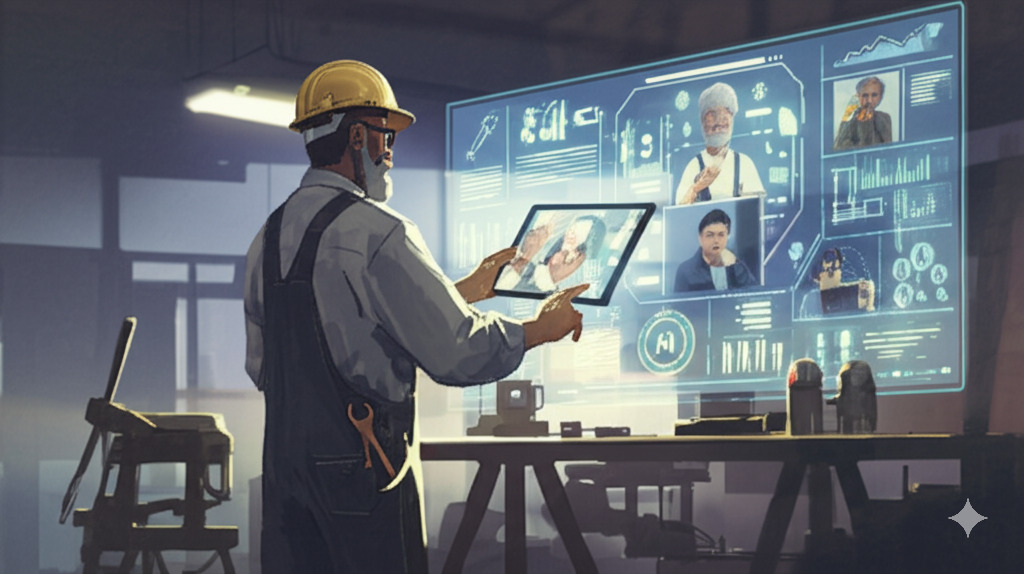The Skills Revolution: Why Upskilling is the Key to Career Survival

The ground beneath the modern workforce is shifting at an unprecedented pace. Decades-old career paths are becoming overgrown, familiar job descriptions are being rewritten, and the very definition of valuable work is undergoing a profound transformation. We are living through a “Skills Revolution,” an era defined by the relentless advance of technology, particularly artificial intelligence (AI) and automation, which is fundamentally reshaping job requirements across nearly every industry. In this dynamic landscape, complacency is the enemy of progress, and the key to not just surviving, but thriving, lies in a single, crucial strategy: continuous upskilling.
For generations, the model was often linear: acquire education, enter a profession, and perhaps gain incremental skills over a long tenure. That model is rapidly becoming obsolete. The skills that secured a job five years ago may be insufficient today and potentially irrelevant in another five. AI and automation are not just futuristic concepts; they are active agents of change, automating routine tasks, augmenting human capabilities, and creating entirely new roles that demand a blend of technical proficiency, critical thinking, and uniquely human attributes. Ignoring this reality is akin to navigating a storm without a compass. This article delves into why upskilling has transitioned from a ‘nice-to-have’ personal development goal to an absolute imperative for career survival, explores the skills most in-demand in today’s workforce, and outlines how employees can proactively embrace continuous learning to secure their future.
The Engine of Change: AI, Automation, and the Future of Work
The narrative around AI and automation often swings between utopian visions of effortless productivity and dystopian fears of mass unemployment. The reality, as is often the case, is far more nuanced. While it’s true that automation is eliminating certain tasks, particularly those that are repetitive, predictable, and data-intensive, it’s simultaneously creating new opportunities and fundamentally changing the nature of existing roles.
Consider tasks like basic data entry, routine report generation, simple customer service queries, or manufacturing line assembly. These are increasingly susceptible to automation. However, this displacement doesn’t necessarily equate to widespread job loss. Instead, it signifies a shift in *value*. The value is moving away from performing the routine task itself and towards:
- Overseeing and Managing Automated Systems: Humans are needed to design, implement, monitor, maintain, and improve the AI and automation tools.
- Working Alongside AI (Augmentation): AI can handle massive datasets and complex calculations far faster than humans, but humans excel at interpreting the results, applying context, making strategic decisions based on AI-driven insights, and communicating findings effectively. Think of a radiologist using AI to flag potential anomalies in scans, allowing them to focus their expertise on diagnosis and treatment planning.
- Performing Tasks Requiring Human Judgment and Empathy: Skills like complex problem-solving in novel situations, creativity, critical thinking, negotiation, emotional intelligence, leadership, and intricate client relationship management remain firmly in the human domain. AI struggles with nuance, ethical ambiguity, and genuine interpersonal connection.
- Developing and Innovating New Technologies and Processes: The creation and advancement of AI and automation itself require highly skilled individuals.
This symbiotic relationship means that jobs aren’t just disappearing; they are evolving. A marketing manager might now need skills in analyzing AI-generated campaign data; a logistics coordinator might need to understand how to optimize routes using automated systems; a writer might use AI tools to assist with research or first drafts, freeing them up for more creative and strategic aspects of content creation. The common thread is the need for workers to adapt, learn how to leverage these new tools effectively, and cultivate the higher-order cognitive and interpersonal skills that technology cannot replicate.

The New Skillset: What Employers Demand in the Modern Workforce
As automation handles the routine, the demand for uniquely human and technically adept skills skyrockets. Traditional qualifications listed on a resume are no longer sufficient. Employers are increasingly looking for a dynamic blend of capabilities that enable individuals to navigate complexity, collaborate effectively, and drive innovation. The most in-demand skills cluster around several key areas:
1. Digital Literacy and Technological Fluency
This goes far beyond basic computer skills. In today’s environment, it means:
- Data Literacy: The ability to understand, interpret, analyze, and communicate insights derived from data. This includes familiarity with data visualization tools and basic analytical concepts.
- AI Familiarity: Understanding the basic principles of AI and machine learning, recognizing its applications within one’s field, and knowing how to interact with AI-powered tools ethically and effectively.
- Cybersecurity Awareness: Basic understanding of digital security threats and best practices to protect sensitive information in an increasingly connected world.
- Proficiency with Collaboration Tools: Mastery of platforms for remote communication, project management, and virtual teamwork (e.g., Slack, Teams, Asana, Trello, Zoom).
- Adaptability to New Software and Platforms: The willingness and ability to quickly learn and utilize new technologies relevant to one’s role or industry.
2. Advanced Cognitive Skills
These are the higher-order thinking abilities that differentiate human intelligence from artificial processing:
- Critical Thinking: Objectively analyzing information, identifying biases, evaluating arguments, and making reasoned judgments.
- Complex Problem-Solving: Identifying intricate problems, evaluating options, and implementing effective solutions, often in novel or ambiguous situations where established procedures don’t apply.
- Creativity and Innovation: Thinking outside the box, generating novel ideas, and finding original solutions to challenges. This is crucial for developing new products, services, and processes.
- Strategic Thinking: Understanding the bigger picture, anticipating future trends, and aligning actions with long-term goals.
3. Social and Emotional Intelligence (The “Human” Skills)
As routine tasks become automated, the value of interpersonal skills becomes paramount:
- Communication: Clearly and effectively conveying information, ideas, and perspectives, both verbally and in writing, across various channels (including digital). Active listening is a critical component.
- Collaboration and Teamwork: Working effectively with others, often in diverse and distributed teams, managing conflict constructively, and contributing to shared goals.
- Emotional Intelligence (EQ): Understanding and managing one’s own emotions, recognizing and influencing the emotions of others, demonstrating empathy, and building strong relationships.
- Leadership and Influence: Motivating and guiding others (formally or informally), building consensus, and driving change, even without direct authority.
- Cultural Intelligence and Diversity Awareness: Navigating and respecting diverse perspectives, backgrounds, and working styles in a globalized and interconnected workplace.
4. Adaptability and Learning Agility
Perhaps the most critical meta-skill in the Skills Revolution:
- Growth Mindset: Believing that abilities can be developed through dedication and hard work; embracing challenges and viewing failures as learning opportunities.
- Resilience: Bouncing back from setbacks, adapting to changing circumstances, and maintaining performance under pressure.
- Learning Agility: The ability and willingness to learn quickly from experience, apply those learnings to new situations, and continuously seek out new knowledge and skills.
- Comfort with Ambiguity: Operating effectively even when goals, requirements, or the path forward are not perfectly clear.
Possessing a combination of these skills transforms an employee from a cog in a machine to a dynamic, adaptable contributor capable of navigating the complexities of the modern workplace.
The Employee Playbook: Taking Ownership of Your Skill Development
The responsibility for upskilling cannot rest solely on employers. While organizations play a crucial role in fostering a learning environment, individual employees must take proactive ownership of their professional development. Waiting to be told what to learn is a recipe for falling behind. Embracing continuous learning is not just about acquiring new technical skills; it’s about cultivating a mindset geared towards lifelong growth.
It Starts with Mindset: Embrace the Growth Mindset
Coined by psychologist Carol Dweck, the “growth mindset” is fundamental to successful upskilling. Individuals with a growth mindset believe their talents and abilities can be developed through effort, learning, and persistence. They embrace challenges, learn from criticism, and find inspiration in the success of others. Contrast this with a “fixed mindset,” where individuals believe their abilities are innate and unchangeable, leading them to avoid challenges and give up easily. Cultivating a growth mindset means viewing skill gaps not as failures, but as opportunities for development.
Strategies for Continuous Learning:
There is no single ‘right’ way to upskill. The most effective approach often involves a blend of different strategies tailored to individual needs, learning styles, and career goals:
- Formal Education & Certifications: This includes traditional routes like university degrees or diplomas, but also increasingly popular options like online courses from platforms (Coursera, edX, Udacity, LinkedIn Learning), professional certifications specific to your industry (e.g., PMP for project management, AWS/Azure for cloud computing, HubSpot for marketing), and intensive bootcamps (especially for tech skills like coding or data science). These provide structured learning paths and recognized credentials.
- Micro-learning & Just-in-Time Skills: Learning doesn’t always require lengthy commitments. Micro-learning involves consuming bite-sized content – short online tutorials, articles, podcasts, webinars, specific modules within larger courses – to acquire specific skills or knowledge exactly when needed. This is ideal for busy professionals needing to quickly grasp a new tool or concept.
- On-the-Job Learning & Stretch Assignments: Your current role is a powerful learning laboratory. Actively seek out opportunities to learn new things within your daily work. Volunteer for projects that push you outside your comfort zone (“stretch assignments”), ask colleagues with different expertise to show you how they approach tasks, shadow someone in a role you aspire to, and don’t be afraid to take on challenges that require you to learn as you go.
- Networking & Mentorship: Learning from others is invaluable. Engage with peers, industry leaders, and mentors. Attend industry conferences (online or in-person), join professional organizations, participate in online forums and communities (like LinkedIn Groups or specialized Discords/Slacks). A good mentor can provide guidance, share experiences, challenge your thinking, and open doors to new opportunities.
- Personal Projects & Side Hustles: Applying newly acquired skills in a real-world context solidifies learning. Start a personal project related to your field (e.g., build a website, analyze a public dataset, write a blog), or even develop a small side hustle. This provides practical experience and demonstrates initiative.
Building a Personal Learning Plan:
A proactive approach requires structure. Develop a personal learning plan:
- Assess Your Current Skills: Honestly evaluate your strengths and weaknesses relative to your current role and future career aspirations. Where are the gaps, especially considering the in-demand skills discussed earlier?
- Identify Your Goals: What do you want to achieve? Learn a specific technology? Move into a leadership role? Improve your data analysis skills? Be specific.
- Research Resources: Based on your goals, identify relevant learning resources – courses, books, mentors, projects, etc.
- Set Realistic Timelines: Break down larger goals into smaller, manageable steps. Schedule dedicated time for learning, even if it’s just a few hours per week.
- Track Your Progress & Reflect: Keep a record of what you’re learning and how you’re applying it. Periodically reflect on your progress and adjust your plan as needed.
Leveraging Employer Resources:
While ownership is key, don’t overlook resources your employer might offer. Many companies recognize the importance of upskilling and provide support such as:
- Internal training programs or workshops.
- Subscriptions to online learning platforms.
- Tuition reimbursement for external courses or degrees.
- Mentorship programs.
- Opportunities for cross-functional projects or job rotation.
Investigate what’s available and actively participate. Demonstrating initiative in utilizing these resources is often viewed positively by management.
The Organizational Imperative: Fostering a Culture of Upskilling
While this article focuses on the employee, it’s crucial to acknowledge the role of organizations. Companies that fail to invest in their workforce’s skills risk obsolescence just as much as individuals do. Forward-thinking organizations understand that upskilling is not just an employee benefit but a strategic necessity for:
- Closing Internal Skills Gaps: It’s often more cost-effective to upskill existing employees than to constantly hire externally.
- Boosting Innovation and Adaptability: A skilled workforce is better equipped to leverage new technologies and adapt to market changes.
- Improving Employee Engagement and Retention: Investing in employee growth demonstrates value and provides pathways for career advancement, leading to higher morale and loyalty.
- Enhancing Employer Brand: A reputation for developing talent attracts top candidates.
Organizations can foster this by creating a genuine culture of learning – one where curiosity is encouraged, learning time is protected, resources are accessible, managers support development goals, and internal mobility based on newly acquired skills is facilitated. It requires moving beyond occasional training sessions to embedding learning into the flow of work.
Overcoming the Hurdles: Addressing Challenges to Upskilling
Embarking on a continuous learning journey is not without challenges. Recognizing these hurdles and planning for them can make the process more sustainable:
- Time Constraints: Perhaps the most common barrier. Busy work schedules and personal commitments leave little room for learning. Solutions: Prioritize ruthlessly. Focus on micro-learning opportunities. Integrate learning into work (e.g., dedicate 30 minutes daily). Negotiate learning time with your manager, highlighting the benefits to your role. Sacrifice lower-priority activities.
- Cost: Formal courses and certifications can be expensive. Solutions: Explore free or low-cost resources (library resources, free tiers of online platforms, open-source software tutorials, podcasts, YouTube). Leverage employer tuition assistance if available. Focus on options with the highest potential return on investment for your career goals. Consider skill-swapping with colleagues.
- Motivation and Overwhelm: The sheer volume of things to learn can feel daunting, leading to inertia or burnout. Solutions: Start small with achievable goals. Focus on skills directly relevant and interesting to you. Find a learning buddy or join a community for support and accountability. Celebrate small wins along the way. Remember your ‘why’ – the career security and opportunities that upskilling provides.
- Lack of Clear Direction: Not knowing *what* skills to learn can be paralyzing. Solutions: Research industry trends (read industry publications, follow thought leaders). Talk to your manager, mentors, or HR about future skill needs. Analyze job descriptions for roles you aspire to. Start broad and narrow down as you discover your interests and see needs emerge.
Conclusion: Thriving in the Age of Transformation
The Skills Revolution is not a temporary disruption; it is the new normal. AI and automation are irrevocably changing the landscape of work, rendering old skills obsolete while creating immense demand for new capabilities – technical, cognitive, and interpersonal. In this environment, clinging to the status quo is no longer a viable option. Career survival, and indeed career success, hinges on embracing continuous learning and proactive upskilling.
For employees, this means taking ownership of professional development. It requires cultivating a growth mindset, identifying critical skill gaps, and actively pursuing learning through a variety of strategies – from formal courses to on-the-job experiences and networking. It demands adaptability, resilience, and a commitment to lifelong learning not as a chore, but as an integral part of a fulfilling and future-proof career.
Upskilling is not merely a defensive measure against automation; it is an act of empowerment. It equips individuals with the tools, knowledge, and confidence to navigate change, seize new opportunities, and shape their own professional futures. The future of work belongs not necessarily to those with the most established expertise today, but to those who are the most adaptable, curious, and committed learners tomorrow. The Skills Revolution is here – are you ready to lead your own evolution?



